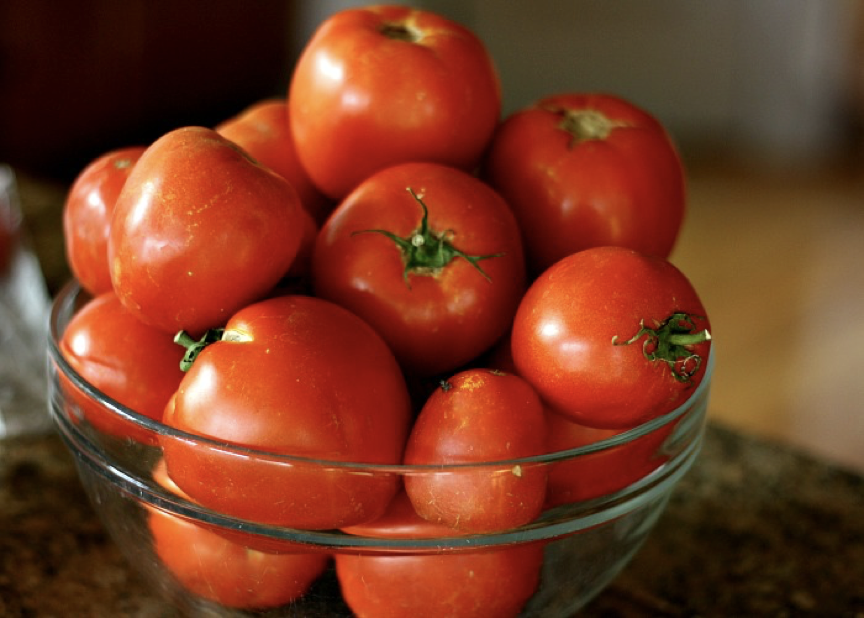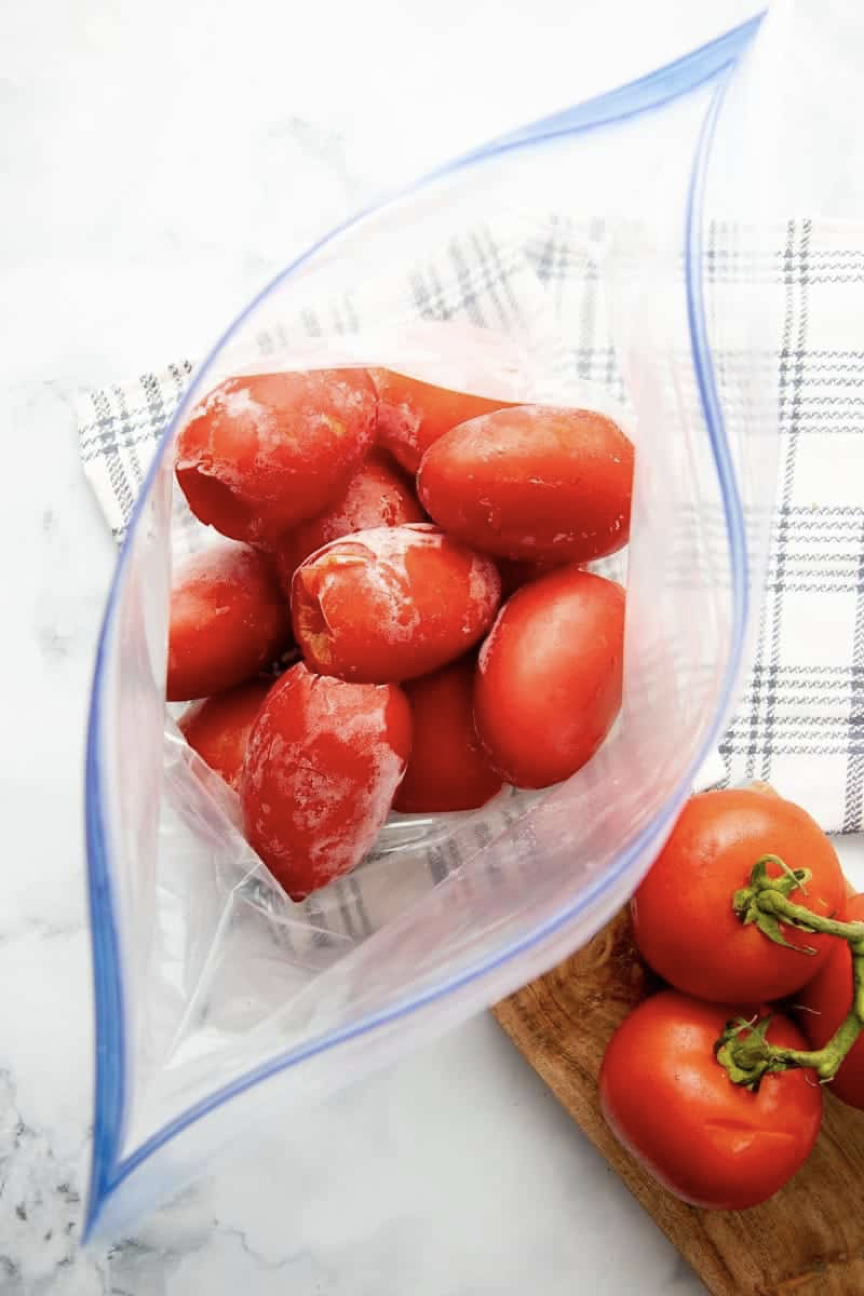FRESH Tomato Sauce and PERFECT Pasta!
In just a few more weeks, fresh tomatoes will abound—locally at farmers’ markets, in our own gardens, and in our grocery stores. This is as much an awaited event as is watermelon season.

One of our favorite summer meals is fresh corn-on-the-cob, thick juicy tomato slices garnished with grated Parmesan cheese and freshly chopped basil, and watermelon for dessert. Oh my.
Fresh tomatoes are also lovely when stuffed with crab, tuna, or egg salad. And if you haven’t tried grilling them with a sprinkle of grated cheese, you should.
But there are only so many fresh tomatoes you can eat, and then something has to be done. I found a great suggestion on the University of Nebraska Home Extension site. The extension agents say we can actually freeze them whole—with or without their skins!

And they don’t need to be blanched before freezing. Frozen tomatoes are best used in cooked foods such as soups, sauces and stews as they become mushy when they're thawed. To use frozen tomatoes, remove them from the freezer a few at a time or all at once and then use them in any cooked-tomato recipe.
Since freezing them with peels on means less work, I’d opt for that approach. So here is what you should do if you want to freeze your whole tomatoes with their skins:


No-cook sauces have a fresh, flavorful, and bright taste, and they’re perfect when you want to include more raw food into the diet. And what’s especially nice, not many ingredients are required, which is a distinct bonus. In my favorite recipe, hot olive oil and salt are added to diced fresh tomatoes and herbs. That’s it.
You need to be careful, though, to add the oil and salt just before tossing with your cooked pasta because the scalded oil releases the flavor of the herbs IMMEDIATELY. Also, the salt will draw too much liquid from the cut tomatoes if added too soon. (In other words, this isn’t a make-ahead sauce.) I like this best with angel hair pasta. Anything heavier doesn’t work as well.

4 pounds ripe tomatoes cored
2 1/2 to 3 tablespoons finely chopped fesh basil
2 1/2 teaspoons finely chopped fresh oregano
3/4 cup cold-pressed extra virgin olive oil
fine Celtic or sea salt to taste
Directions:
Add Recipe to Cook'n
And now how about a few tips for perfectly-cooked pasta? First: Use a LARGE pot that will accommodate lots of rapidly boiling water—at least 6 quarts for 1 pound of pasta.
Next, don’t chince on the salt. 2 tablespoons of fine Celtic or sea salt is the minimum amount to add. This might seem excessive, but without enough salt, the pasta lacks flavor.
Then, cook to al dente. Stir the pasta and test. You’ll know it’s al dente when the pasta is a bit firm when biting into it, but not hard in the center. When you’ve reached this stage, drain and quickly toss with your sauce.
Finally, never rinse pasta. Doing so washes away the starch coating the helps sauces cling to the pasta. Sauce-cling, that’s what you want.

One of our favorite summer meals is fresh corn-on-the-cob, thick juicy tomato slices garnished with grated Parmesan cheese and freshly chopped basil, and watermelon for dessert. Oh my.
Fresh tomatoes are also lovely when stuffed with crab, tuna, or egg salad. And if you haven’t tried grilling them with a sprinkle of grated cheese, you should.
But there are only so many fresh tomatoes you can eat, and then something has to be done. I found a great suggestion on the University of Nebraska Home Extension site. The extension agents say we can actually freeze them whole—with or without their skins!

And they don’t need to be blanched before freezing. Frozen tomatoes are best used in cooked foods such as soups, sauces and stews as they become mushy when they're thawed. To use frozen tomatoes, remove them from the freezer a few at a time or all at once and then use them in any cooked-tomato recipe.
Since freezing them with peels on means less work, I’d opt for that approach. So here is what you should do if you want to freeze your whole tomatoes with their skins:

- Select firm, ripe tomatoes for freezing. Sort the tomatoes, discarding any that are spoiled.
- Gently rub tomatoes under cold running water and then dry with a paper towel or a clean cloth.
- After washing, cut away the stem scar and surrounding area and discard it.
- Place the whole tomatoes on clean cookie sheets and freeze.
- Once frozen, transfer the tomatoes from the cookie sheets into freezer bags or other containers. Seal tightly and freeze.

No-cook sauces have a fresh, flavorful, and bright taste, and they’re perfect when you want to include more raw food into the diet. And what’s especially nice, not many ingredients are required, which is a distinct bonus. In my favorite recipe, hot olive oil and salt are added to diced fresh tomatoes and herbs. That’s it.
You need to be careful, though, to add the oil and salt just before tossing with your cooked pasta because the scalded oil releases the flavor of the herbs IMMEDIATELY. Also, the salt will draw too much liquid from the cut tomatoes if added too soon. (In other words, this isn’t a make-ahead sauce.) I like this best with angel hair pasta. Anything heavier doesn’t work as well.

Versatile Fresh Tomato Sauce
Yield: 4 cups
Ingredients:
4 pounds ripe tomatoes cored
2 1/2 to 3 tablespoons finely chopped fesh basil
2 1/2 teaspoons finely chopped fresh oregano
3/4 cup cold-pressed extra virgin olive oil
fine Celtic or sea salt to taste
Directions:
Peel the tomatoes with a vegetable peeler. Cut into quarters and remove and discard the seeds. Dice and transfer to a large serving bowl. Add the basil and oregano. Gently fold ingredients to coat tomato with herbs.
Immediately prior to serving, heat the olive oil over medium-low heat in small saucepan until hot (but not smoking); add salt and pour over the tomato mixture. Mix well. Toss sauce with cooked pasta and serve. TIP: This is especially nice with tiny mozzarella balls mixed in.
Immediately prior to serving, heat the olive oil over medium-low heat in small saucepan until hot (but not smoking); add salt and pour over the tomato mixture. Mix well. Toss sauce with cooked pasta and serve. TIP: This is especially nice with tiny mozzarella balls mixed in.
Recipe formatted with the Cook'n Recipe Software from DVO Enterprises.
And now how about a few tips for perfectly-cooked pasta? First: Use a LARGE pot that will accommodate lots of rapidly boiling water—at least 6 quarts for 1 pound of pasta.
Next, don’t chince on the salt. 2 tablespoons of fine Celtic or sea salt is the minimum amount to add. This might seem excessive, but without enough salt, the pasta lacks flavor.
Then, cook to al dente. Stir the pasta and test. You’ll know it’s al dente when the pasta is a bit firm when biting into it, but not hard in the center. When you’ve reached this stage, drain and quickly toss with your sauce.
Finally, never rinse pasta. Doing so washes away the starch coating the helps sauces cling to the pasta. Sauce-cling, that’s what you want.
Sources:
www.happymoneysaver.com
www.wholefully.com
www.thisweekfordinner.com
www.inhabitedkitchen.com
 Alice Osborne
Alice Osborne
Weekly Newsletter Contributor since 2006
Email the author! alice@dvo.com
